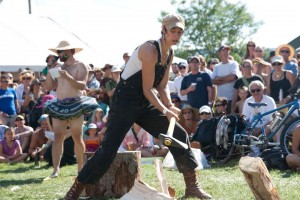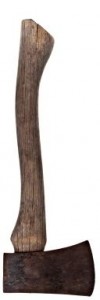ast weekend, my friend Sarah Gilman won the women’s woodsplitting competition at the 41st annual Mountain Fair in Carbondale, Colo., out-chopping several close rivals — including a local county commissioner — and taking home a championship tiara and an six-pound splitting maul. It was Sarah’s second tiara, and second prize maul; she first won the contest when she entered on a whim in 2009. (She also owns a fancy splitting axe from Sweden, a gift from an admiring but anonymous spectator.)
Sarah learned how to swing a sledgehammer during several summers building mountain trails for the Colorado Fourteeners Initiative, then honed her axe skills splitting firewood for cold rural winters. Splitting wood is fun, she says, and meets both tangible and intangible needs. Its satisfying physics once helped her through a breakup, and have long since cured her of a recurring dream in which she frantically tried to build her strength by doing pullups inside a moving bus.
For aspiring woodsplitters who feel a wee awkward around swinging tools (Okay, people, I can hear you. No more sniggering until the end of this post!), Sarah offers these tips.
- Let gravity help you. Start your swing with your axe held vertically overhead and your hands separated. As you bring the tool down, slide your hands together on the handle to make the radius of your swing as long as possible. A longer radius means greater linear velocity.
- Don’t roundhouse. Starting your swing at the ground and bringing the axe overhead looks cool, but doesn’t necessarily strengthen your chop. Besides, roundhousers risk tossing loose axe heads or entire tools toward unlucky onlookers.

- Be tall. The higher the axe is raised, the greater potential energy it has, and the more energy it will eventually deliver to the log. Strength helps too, of course, but statuesque Sarah — who’s just a half-inch shy of six feet — thinks height has the edge. That said, good technique can sometimes beat both physical advantages.
- Use the heaviest tool you can handle without slowing down your swing. More weight means more momentum.
- Practice tool safety. Carry tools at your side, not over your shoulder. Wear protective shoes.
- Exploit your gender’s advantages. Male competitors usually have faster times than their female counterparts, thanks to their generally greater height, upper-body strength, and, well, tool experience. But Sarah and her rivals aren’t far behind. “And women dress better,” she laughs. This year, Sarah took home her woodsplitting honors while wearing tall cowboy boots and a denim tube dress (topped with a vest to hide any wardrobe malfunctions) — a choice that won swing-strengthening support from the audience.
Happy chopping, dear readers.
Axe image from iStockphoto.
Photo by Corie Spruill.

Sarah has my absolute admiration to the point of envy, the amount of physics she uses is interesting and impressive, but what I really need to know is, what’s going on with the naked dudely person wearing earrings, a hat, and what looks like an umbrella?
Can I just say how much I love that axe as the letter L? It takes me back to some of the favourite books of my childhood.
Ann, I wondered that myself – also, how does he manage to look somewhat official in spite of the umbrella/inner tube? I’ll make inquiries.
And thanks, Jessa! Me too.
Ann, Sarah says, “As for Mr. Dudely in the innertube, he’s the MC. This year he was ‘Nurse McCreamy’ and sported a mullet wig, a nurse’s cap that looked like a Chinese takeout container and a pair of scrubs trousers pulled low enough to reveal a whale tale.”
Aren’t you sad you missed it?
I’m sadder than I can say. I didn’t even know about it. I would have made a special trip. And did I ever tell you how my grandmother was the first and maybe only woman to have won the Wheatland Plowing match? No sniggering about that either.
I sense a theme emerging – Thank God It’s Iron Age Technology Wednesday …